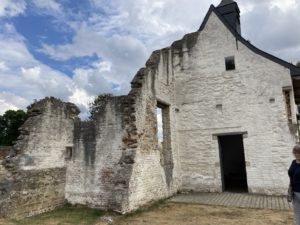As you might realize, most of my books’ heroes are British Army officers. Perhaps because I grew up as an army brat, the daughter of an army colonel. I’ve placed many of my heroes (and heroines) at the Battle of Waterloo. Imagine my excitement, then, when my friend Kristine Hughes of Number One London Tours (and author of the fabulous Waterloo Witnesses) offered a Waterloo tour this year. I’ve traveled often with Kristine and every one of her tours is fabulous. The Waterloo Tour was no exception. Kristine brought in Gareth Glover, author of several books about the battle and the Napoleonic War, to be our expert guide at Waterloo.
The tour covered all the sites relevant to the battle. Here are some highlights:
The Lion’s Mound

The Lion’s Mound was built in 1820 by King William I on the battlefield at the spot where his son, the Prince of Orange was shot in the shoulder. Lest you think the Prince was a hero, know his inexperience and incompetence got several of his soldiers killed.
Next to the Lion’s Mound was a wonderful Waterloo museum, featuring a 3-D depiction of the battle that put you right in the action.
Hougoumont
 Hougoumont was one of the farms on the battlefield that saw the first action of the battle. The Allies, commanded by the Duke of Wellington, managed to hold the fort until the very end, although Napoleon made it a priority to be captured.
Hougoumont was one of the farms on the battlefield that saw the first action of the battle. The Allies, commanded by the Duke of Wellington, managed to hold the fort until the very end, although Napoleon made it a priority to be captured.
Hougoumont is now a museum and featured another film of the battle.
La Haye Sainte
 La Haye Sainte was the farm on the other side of the battle, another strategic place of the battle held by the King’s German Legion, one of Wellington’s divisions, until the Legion’s ammunition ran out and the French finally took possession.
La Haye Sainte was the farm on the other side of the battle, another strategic place of the battle held by the King’s German Legion, one of Wellington’s divisions, until the Legion’s ammunition ran out and the French finally took possession.
The farm is now privately owned and not open to the public so we could only gaze at the outside of it.
 We walked the battlefield while Gareth explained the battle. I’ve done a lot of reading about the battle and I was pleased that I got most things right in my books.
We walked the battlefield while Gareth explained the battle. I’ve done a lot of reading about the battle and I was pleased that I got most things right in my books.
This view of the battlefield is from the top of the Lion’s Mound (a 226 step climb). The land was farmland then and is farmland now.
Apsley House
 We had one day in London to walk the sights that related to the battle. When Wellington returned victorious, all sorts of awards were heaped on him, including the funds for a London house and a country estate. So we visited Number One London, Apsley House’s address.
We had one day in London to walk the sights that related to the battle. When Wellington returned victorious, all sorts of awards were heaped on him, including the funds for a London house and a country estate. So we visited Number One London, Apsley House’s address.
The house is one of my favorite sites in London and I’ve visited it several times. It is now a museum filled with the treasures heaped upon Wellington after the battle.
The Tour was everything I’d hoped it would be and left me with many memories I’ll always cherish.

















